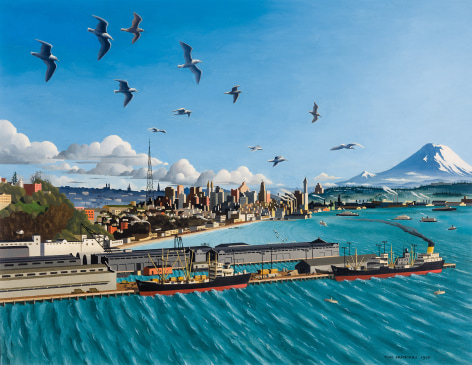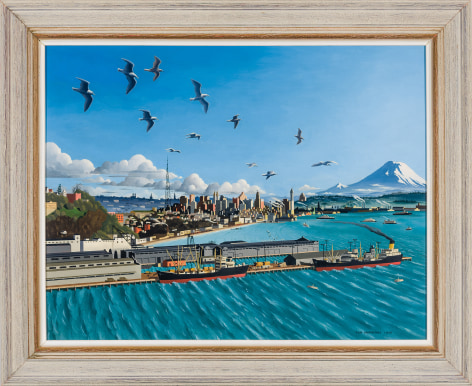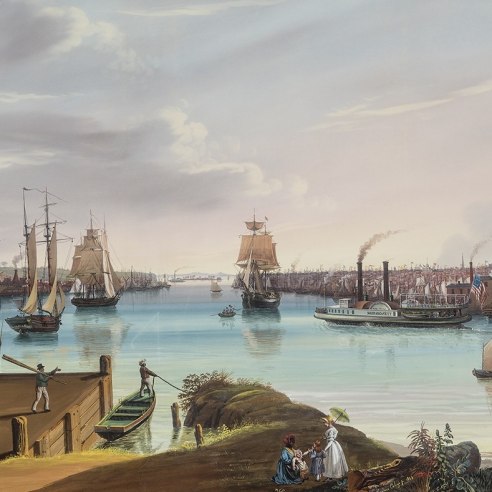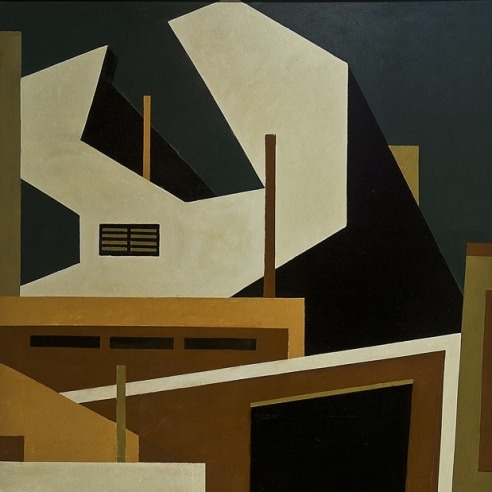
THOMAS FRANSIOLI (1906–1997)
View of Seattle, 1950
Oil on canvas, 21 x 27 in.
Signed and dated (at lower right): TOM FRANSIOLI 1950
RECORDED: Collier’s, March 11, 1950, cover illus. in color
EX COLL.: private collection, Seattle, and by descent until 2022
Collier’s was a venerable illustrated weekly, publishing a high level of journalism, opinion, and fiction in competition with its rival, The Saturday Evening Post. In 1949, Collier’s contracted with Fransioli for an ambitious series of 30 large-scale cityscapes, iconic views of large American cities that would be published as cover illustrations for the magazine over a 5-year period. Fransioli was surprised that the magazine would take on “a fine arts painter,” but the offer was too lucrative to refuse. Fransioli and his wife, Elizabeth, bought a new car and set out across the country, visiting St. Louis, Philadelphia, Cleveland, Indianapolis, Chicago, San Francisco, Seattle, and New Orleans. In all these cities Fransioli worked to capture in his sketches the spirit of the city as expressed in its physical presence. The series also included a view of New York, giving pride of place, unsurprisingly, to the new (1950) Crowell Collier building at 640 Fifth Avenue at 51st Street.
Fransioli's view of Seattle appeared on the cover of the March 11, 1950, issue of Collier’s Magazine. Seattle is strategically located on Puget Sound, with its downtown area embracing the curved shore of Elliott Bay, providing a natural deep-water port. When Fransioli returned to paint the Seattle skyline in 1950, it was still dominated by the 1914 Smith Tower Building. Perched on the south (right) edge of the urban area, the Tower is unmistakable with its distinctive pyramid top. It is in the Pioneer Square neighborhood, the origin point of the “great fire” that destroyed Seattle’s original downtown district in 1889. Originally constructed on filled-in marshes, when the area was speedily rebuilt, this time with brick construction, it was elevated 13 to 30 feet above the old street level, resulting in a series of underground passages that can still be visited today. The Smith Tower Building, developed by the Smith family of Smith Corona Typewriter fame, rises 38 stories and about 480 feet high. Until 1931 it was the tallest building west of the Mississippi River. It remained the tallest building in Seattle until the Space Needle was constructed for the 1962 Seattle World’s Fair. The cluster of high-rise buildings to the left of the Tower in Fransioli’s picture preside over a low-rise city and reflect the commercial building boom of the 1920s. The skeletal metal tower in the right center of Fransioli’s picture is the KJR / KOMO radio transmitter, located in 1950 a few blocks from the present Space Needle. On the far right of the canvas, Fransioli included Mount Rainier, an imposing presence in the life of the city. In fact, Mount Rainier, which is an active volcano with a peak 14,410 ft. above sea level, is about a hundred miles away.
What Thomas Fransioli couldn’t have known when he returned to Seattle, Collier’s commission in hand, was that he was documenting the physical remains of the end of an era in Seattle history. Mid-century proved a specific moment in time when the city still retained a the defining physical presence of its late-19th / early-20th-century origins. Soon after Fransioli recorded the scene, building commenced on the Alaska Way Viaduct, an elevated highway that ran along the city’s waterfront. This road separated the city from the bay from 1953 until 2013 when it was deemed vulnerable to earthquake damage. Between 2013 and 2019, it was replaced with a combination of surface highway and downtown tunnel which allowed for its complete demolition. The greatest change to the Seattle skyline, Seattle, however, since Fransioli made his painting, has been the construction, beginning in the late-twentieth century and ongoing, of a forest of modern skyscrapers. Were Thomas Fransioli to see downtown Seattle today, it would be indistinguishable from many other major cities of American and Europe, except, of course, for the landmarked Smith Tower Building. Terracotta over steel, rising above a two-story granite base, it still stands with its neo-classical dignity intact, now at the old southern edge of the city, while the heart of the commercial area has moved north along the Bay.




